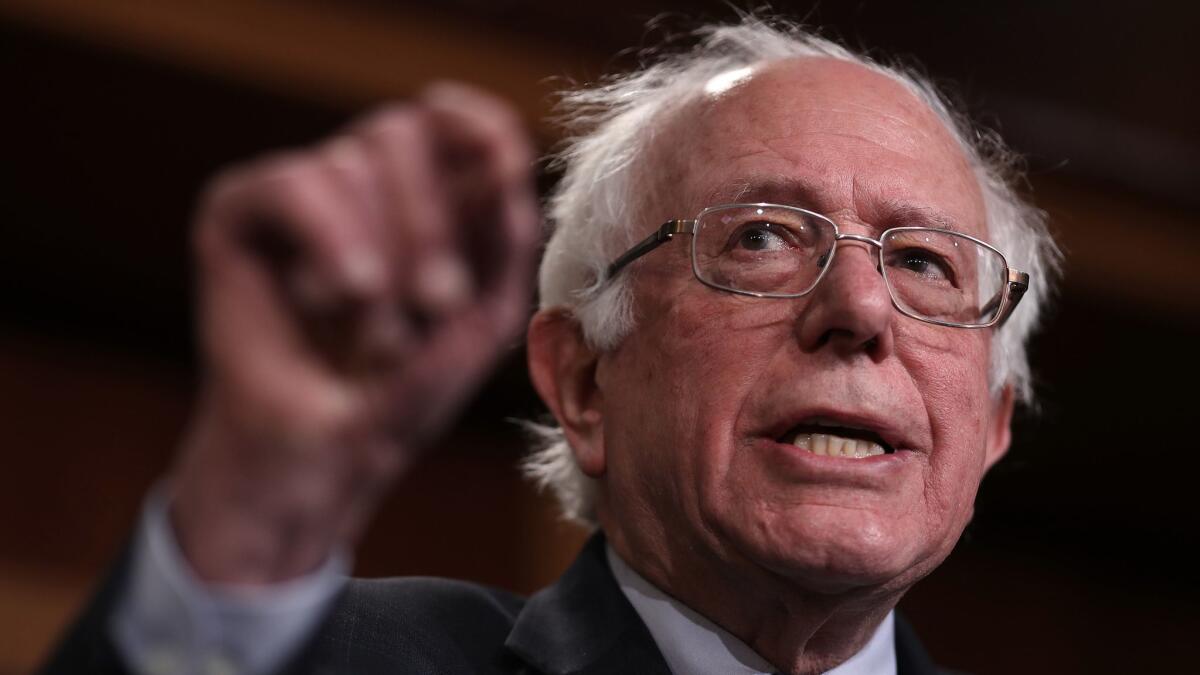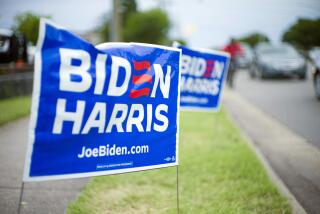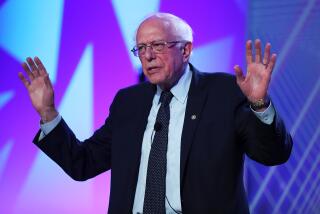Can Bernie Sanders re-create the magic? Vermont senator joins 2020 Democratic race

- Share via
Reporting from Washington — The return of Vermont Sen. Bernie Sanders to presidential politics this week will test how much the Democratic Party has truly shifted to the left as well as gauge the resilience of a self-proclaimed democratic socialist candidate whose message has changed little even as the political landscape around him has shifted.
Sanders plunged into the 2020 race Tuesday with a campaign video recapping many of the promises of his 2016 effort: Medicare for all, free college tuition for all and the dismantling of what he calls the rigged economy favoring the wealthy.
But he did so at a time other candidates in the race — many of whom rode his coattails to progressive prominence — are modulating their visions for expanding government and increasing taxes on the rich.
“We began the political revolution in the 2016 campaign, and now it’s time to move that revolution forward,” Sanders said in a radio interview.
He described President Trump as a “pathological liar,” adding, “I also think he is a racist, a sexist, a homophobe, a xenophobe, somebody who is gaining cheap political points by trying to pick on minorities, often undocumented immigrants.”
The Democratic Party has clearly moved at least partway toward Sanders in the last couple of years. At the same time, however, the candidates drawing overflow crowds in New Hampshire over Presidents Day weekend were hardly rushing to follow the same path Sanders used en route to a 22-percentage-point victory in the state over Hillary Clinton.
“The people of New Hampshire will tell me what’s required to compete in New Hampshire, but I will tell you I am not a democratic socialist,” California Sen. Kamala Harris said Monday.
Her comments came soon after Sen. Amy Klobuchar, answering questions during a CNN town hall, said, “I am not for free four-year college for all, no.”
“If I was a magic genie and could give that to everyone, and we could afford it, I would,” she added.
Massachusetts Sen. Elizabeth Warren, the candidate who is probably closest to Sanders ideologically, has also carefully avoided his “socialist” label, saying she favors “capitalism with serious rules.”
Former Rep. Beto O’Rourke of Texas, who is weighing his own run and draws support from many young voters, much as Sanders did, has also been reaffirming that he is a capitalist.
Sanders is in a very different race than the one he nearly upended in 2016, when he was the only progressive in a tiny field led by Clinton. This time around, several other candidates will vie to represent the party’s left, and many progressives, including some former prominent supporters of his, are skeptical that Sanders is best suited to carry their mantle.
But his sustained popularity in early voting states, massive network of small donors and powerhouse digital operation, including a social media network far larger than that of any Democrat, give Sanders big advantages as the race gets underway.
“He’s got a very strong, loyal following,” said Joe Trippi, who has advised campaigns for several major Democrats. “It makes him somebody the rest of the field has to take very seriously, and who has a better shot than many of them at emerging as one of the three or four who actually competes long term for the nomination.”
The transformative campaign the 77-year-old ran in the last presidential cycle drew masses of disaffected voters, including many millennials, to politics. The senator’s plans for expanding government, especially in guaranteeing health coverage, and his excoriations of the wealth of the richest Americans are now embedded in the Democratic Party’s platform.
As much as he changed the party’s positions, Sanders’ bigger impact may have been in proving the viability of a new model for how to sustain a campaign. He unleashed a small-donor revolution that enabled him to raise unprecedented amounts without taking a dime from corporate political action committees or getting trapped in the relentless cycle of big-dollar fundraisers.
Some 2.5 million Americans gave to him in the last presidential cycle. His invocation of the size of the average donation — $27 — became a staple of his campaign rallies, which routinely drew audiences that dwarfed those at events held by Clinton. More than 1.4 million people came out to see him.
If Sanders this time around raises only half the $228 million he did in his last run, he’d have a war chest most of the other candidates could only envy. Sanders is well-positioned to get there, said Nicco Mele, director of Harvard’s Shorenstein Center on Media, Politics and Public Policy, who helped run the pioneering digital operation for former Vermont Gov. Howard Dean’s 2004 presidential bid.
“It is a big number,” Mele said, “but the easiest way to get there is through people who have already invested in you, and for them it is not that much money they are contributing.”
The question hanging over Sanders now is whether his moment has passed.
“This is not 2016,” said Ray Buckley, chairman of the New Hampshire Democratic Party. “His argument now is not the message; it’s, ‘I’m the best person to deliver the message.’” In its launch video, the Sanders campaign emphasizes how the progressive policies others tout started with him.
As Sanders wins points with voters for his unyielding conviction and message clarity, pieces of his agenda could unnerve primary voters who are particularly focused on finding a winning candidate to put up against Trump. Americans like many of the ideas Sanders proposes — at least in the abstract — but they get skittish when presented with the costs and other fine print.
The independent senator’s rivals appear to have taken note of that and have embraced some of his slogans while leaving themselves room to tinker with how the programs are defined. Sanders doesn’t.
Sanders faces some other difficulties, as well. Some of the activists who helped propel his campaign in 2016 have expressed ambivalence this time, as have some of the influential celebrities and politicians who once rallied behind him.
Many activists in a party that skews increasingly diverse and younger are wary of nominating a white man who would be 79 by the time he would take office.
Last month, campaign workers from the 2016 effort spoke out about being sexually harassed and discriminated against by colleagues, and having their complaints ignored. The senator apologized in January, telling reporters he had been unaware of the allegations.
But a remark to CNN that he had not been on top of the situation because “I was a little bit busy running around the country trying to make the case” to be elected reinforced the perception among Sanders’ critics that the senator was insufficiently serious about issues of harassment and discrimination.
Who’s in and who’s still on the fence? »
The first big move Sanders made after launching his campaign Tuesday was hiring a well-respected Muslim civil rights activist, Faiz Shakir, as his campaign manager. Shakir joined the campaign from the ACLU, where he was political director.
Sanders is from a state that is 95% white, and connecting with black voters proved a fatal challenge in his last run. Those voters will probably hold at least as much sway in the current contest; states in which African Americans make up a large share of those voting in the Democratic primary, including South Carolina, Virginia and Louisiana, are expected to be particularly influential in choosing the nominee.
Yet Sanders is adept at defying the conventional wisdom — and even defying his own reputation. He’s retooled his approach to nonwhite voters, more effectively adopting the language of racial justice advocates.
The gruff septuagenarian who talks like a Luddite when he describes his own use of technology built one of the most potent online political networks in American history.
Sanders’ digital reach eclipses that of other Democrats who are at least considering a run. He has amassed 32.3 million followers on social media, according to rankings compiled by Acronym, a progressive digital advocacy firm. The next closest Democratic hopeful, Warren, does not have even half as many.
Interviews and town halls Sanders broadcasts on his Senate Facebook page routinely attract more than a million viewers. One recent example, a “Solving Our Climate Crisis” forum he held with Rep. Alexandria Ocasio-Cortez (D-N.Y.), was among the events progressives successfully leveraged to force House Democratic leaders to push climate change to a more prominent place on their agenda.
Overall, clips produced by the Sanders in-house television network, on a shoestring budget with barely any staff, attracted 800 million views in 2017, according to New York magazine. It was an audience bigger than that of CNN.
That all has kept Sanders at the forefront of 2020 conversations in the diners and hardware stores of Iowa and New Hampshire, even as some Washington operatives write him off as yesterday’s news.
The latest look at the Trump administration and the rest of Washington »
More stories from Evan Halper »
[email protected] | Twitter: @evanhalper
More to Read
Get the L.A. Times Politics newsletter
Deeply reported insights into legislation, politics and policy from Sacramento, Washington and beyond. In your inbox twice per week.
You may occasionally receive promotional content from the Los Angeles Times.











